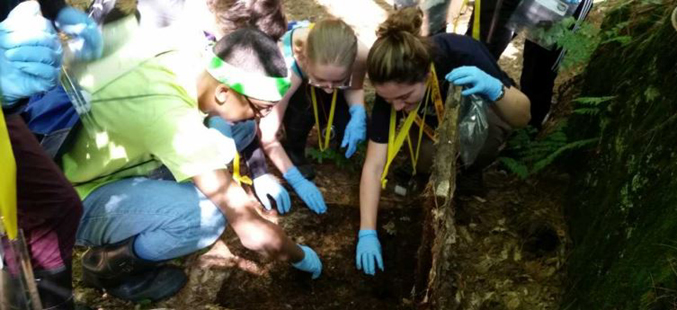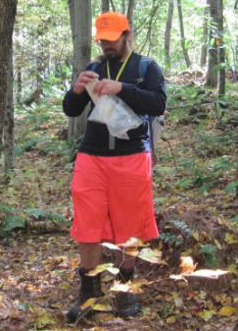Discovering MCLAs 60-Acre Forest
January 10, 2019

Above, MCLA STEM Academy students look under a cover board in search of salamanders. Below, environmental studies major Jordan Teixeira ’18 checks on a project in the forest.
 Did you know that MCLA’s campus includes its own 60-acre forest? Located in the heart
of the Berkshire Mountains, it’s filled with mature, second-growth mixed hardwood
trees, and is used for teaching, ongoing research, ecological monitoring, outdoor
classes, student-led projects, and more.
Did you know that MCLA’s campus includes its own 60-acre forest? Located in the heart
of the Berkshire Mountains, it’s filled with mature, second-growth mixed hardwood
trees, and is used for teaching, ongoing research, ecological monitoring, outdoor
classes, student-led projects, and more.
“Students and faculty use the MCLA forest as part of courses and independent research on vegetation community structure and phenology, soil science, vernal pool ecology, and wildlife,” said Dr. Elena Traister, MCLA environmental studies professor. “Because it is located within walking distance of campus, students can conveniently access it independently, and we can easily spend an entire lab period in our own ‘living laboratory,’ acquiring up-close hands-on knowledge of concepts and techniques we discuss in the classroom.”
Students who attend MCLA’s STEM (Science, Technology, Engineering and Math) Academy during the summer also venture into the forest to count and measure red-backed salamanders, which, back in 2013, were placed under 42 cover boards. Throughout the regular school year, students from various classes also visit the boards to monitor the salamanders, and the soil where they live.
The forest’s trail network connects to the Windsor Lake Park trails, which are less than a half-mile walk from MCLA’s residence halls. Beyond the campus forest, the College is surrounded by 10,000 acres of some of New England’s most pristine forests, which students, faculty and staff also take full advantage of.
Environmental Studies students may study fish at Clarksburg State Park, explore old growth forests in Mohawk Trail State Forest, visit the boreal forests on Mount Greylock, find songbirds on the floodplains of the Hoosic River, use trail cameras to sample deer and bears, and snowshoe into the Moran Wildlife Management Area to look for overwintering birds, as well as many other field activities in the profuse natural areas in the region.
